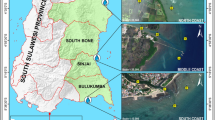Abstract
Diatom densities in the surface water and dinoflagellate cysts in bottom sediments of Gwangyang Bay were studied to determine changes in the phytoplankton community structure in response to anthropogenic eutrophication and to assess the use of dinoflagellate cysts as indicators of coastal eutrophication. Our results show that, in nutrient-enriched environments, diatoms are particularly benefited from the nutrients supplied and, as a consequence, heterotrophic dinoflagellates that feed on the diatoms can be more abundant than autotrophic dinoflagellates. In short-core sediment records, a marked shift in autotrophic–heterotrophic dinoflagellate cyst compositions occurred at a depth of approximately 9–10 cm corresponding to the timing of the 1970s industrialization around Gwangyang Bay. This tentatively indicates that diatom and dinoflagellate communities here have undergone a considerable change mainly due to increased nutrient loadings from both domestic sewage effluent and industrial pollution. Our study suggests a possible potential use of dinoflagellate cysts in providing retrospective information on the long-term effects of coastal eutrophication.



Similar content being viewed by others
References
Andren, E. 1999. Changes in the composition of the diatom flora during the last century indicate increased eutrophication of the Oder Estuary, South-western Baltic Sea. Estuarine, Coastal and Shelf Science 48: 665–676.
Boynton, W.R., J.H. Garber, R. Summers, and W.M. Kemp. 1995. Inputs, transformations, and transport of nitrogen and phosphorus in Chesapeake Bay and selected tributaries. Estuaries 18: 285–314.
Chan, A.T. 1978. Comparative physiological study of marine diatoms and dinoflagellates in relation to irradiance and cell size. I. Growth under continuous light. Journal of Phycology 14: 396–402.
Cho, H.J. and K. Matsuoka. 2001. Distribution of dinoflagellate cysts in surface sediments from the Yellow sea and East China Sea. Marine Micropaleontology 42: 103–123.
Colman, S.M. and J.F. Bratton. 2003. Anthropogenically induced changes in sediment and biogenic silica fluxes in Chesapeake Bay. Geology 31(1): 71–74.
Conley, D.J., C.L. Schelske, and E.F. Stoermer. 1993. Modification of the biogeochemical cycle of silica with eutrophication. Marine Ecology Progress Series 101: 179–192.
Dale, B. 2009. Eutrophication signals in the sedimentary record of dinoflagellate cysts in coastal waters. Journal of Sea Research 61: 103–113.
Dale, B. and A. Fjellså. 1994. Dinoflagellate cysts as paleoproductivity indicators: State of the art, potential, and limits. In Carbon cycling in the glacial ocean: Constraints on the ocean's role in global change, ed. R. Zahn, T.F. Pedersen, M.A. Kaminski, and L. Labeyrie, 521–537. Berlin: Springer.
Diaz, R.J. 2001. Overview of hypoxia around the world. Journal of Environmental Quality 30: 275–281.
Falkowski, P.G., Z. Dubinsky, and K. Wyman. 1985. Growth–irradiance relationships in phytoplankton. Limnology and Oceanography 30: 311–321.
Hamel, D., A. de Vernal, M. Gosselin, and C. Hillaire-Marcel. 2002. Organic-walled microfossils and geochemical tracers: Sedimentary indicators of productivity changes in the North Water and northern Baffin Bay during the last centuries. Deep-Sea Research. Part 2. Topical Studies in Oceanography 49(22–23): 5277–5295.
Hydrographic Office of Korea. 1986. Chart no. 256, Gwangyang Man and Yeoja Man.
Hyun, S.M., T.H. Lee, J.S. Choi, D.L. Choi, and H.J. Woo. 2003. Geochemical characteristics and heavy metal pollutions in the surface sediments of Gwangyang and Yeosu Bay, south coast of Korea. Journal of the Korean Society of Oceanography 8(4): 380–391.
Korea Ocean Research and Development Institute. 2003. Investigation on sedimentation rates for mathematical model verification (BSPS 308-00-1538-4).
Langdon, C. 1987. On the causes of interspecific differences in the growth–irradiance relationship for phytoplankton. Part 1. A comparative study of the growth irradiance relationship of three marine phytoplankton species: Skeletonema costatum, Olisthodiscus luteus and Gonyaulax tamarensis. Journal of Plankton Research 9: 459–482.
Lee, J.B. and K.I. Yoo. 1991. Distribution of dinoflagellate cysts in Masan Bay, Korea. Journal of Oceanological Society of Korea 4: 304–312.
Lee, Y.S., C.K. Kang, Y.K. Choi, and S.Y. Lee. 2007. Origin and spatial distribution of organic matter at Gwangyang Bay in the fall. Journal of the Korean Society of Oceanography 12(1): 1–8.
Lewis, J., J.D. Dodge, and A.J. Powell. 1990. Quaternary dinoflagellate cysts from the upwelling system offshore Peru, Hole 686B, ODP LEG 112. Proceedings of the Ocean Drilling Program, Scientific Results 112: 323–327.
Malone, T.C., D.J. Conley, T.R. Fisher, P.M. Glibert, L.W. Harding, and K.G. Sellner. 1996. Scales of nutrient-limited phytoplankton productivity in Chesapeake Bay. Estuaries 19: 371–385.
Matsuoka, K. 1999. Eutrophication process recorded in dinoflagellate cyst assemblages: A case of Yokohama Port, Tokyo Bay, Japan. Science of the Total Environment 231: 17–35.
Radi, T. and A. de Vernal. 2004. Dinocyst distribution in surface sediments from the northeastern Pacific margin (40–601N) in relation to hydrographic conditions, productivity and upwelling. Review of Palaeobotany and Palynology 128(1–2): 169.
Shim, J.H., Y.K. Shin, and W.H. Lee. 1984. On the phytoplankton distribution in the Kwangyang Bay. Journal of the Korean Society of Oceanography 19(2): 172–186.
Tang, E.P.Y. 1995. The allometry of algal growth rates. Journal of Plankton Research 17: 1325–1335.
Taylor, F.J.R. 1987. Ecology of dinoflagellates. In The biology of dinoflagellates, ed. F.J.R. Taylor. Oxford: Blackwell Scientific.
Tiselius, P. and M. Kuylenstierna. 1996. Growth and decline of a diatom spring bloom phytoplankton species composition, formation of marine snow and the role of heterotrophic dinoflagellates. Journal of Plankton Research 18: 133–155.
Turner, R.E. and N.N. Rabalais. 1994. Coastal eutrophication near the Mississippi river delta. Nature 368: 619–621.
Wall, D., B. Dale, G.P. Lohman, and W.K. Smith. 1977. The environmental and climatic distribution of dinoflagellate cysts in the North and South Atlantic and adjacent seas. Marine Micropaleontology 30: 319–343.
Acknowledgements
We thank the anonymous reviewers for their useful suggestions to improve the quality of the manuscript and for correcting the English. This study was supported by the Korea Ocean Research and Development Institute research program under grant no. PE98314.
Author information
Authors and Affiliations
Corresponding author
Rights and permissions
About this article
Cite this article
Kim, SY., Moon, CH., Cho, HJ. et al. Dinoflagellate Cysts in Coastal Sediments as Indicators of Eutrophication: A Case of Gwangyang Bay, South Sea of Korea. Estuaries and Coasts 32, 1225–1233 (2009). https://doi.org/10.1007/s12237-009-9212-6
Received:
Revised:
Accepted:
Published:
Issue Date:
DOI: https://doi.org/10.1007/s12237-009-9212-6




